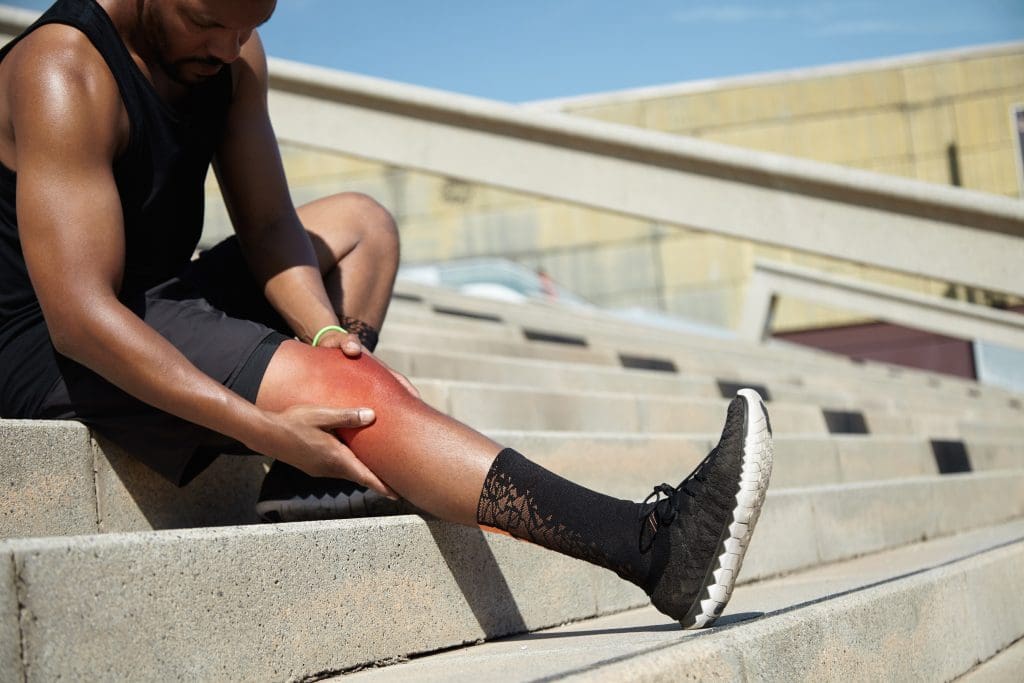
You’re probably not a runner if you haven’t experienced knee pain at some point. Running, as a high-impact exercise, does lend itself to the occasional aches and pains. However, if these aches and pains start to become consistent, then you want to get them under control as soon as possible.
Running with knee pain will only worsen it and can lead to other possible injuries as your body tries to compensate for the pain by putting stress elsewhere. The best way to get your knee pain under control is to find the likely cause and address it at the root.
Once you know the cause, you can address the issue and enjoy running without discomfort.
WHAT ARE COMMON CAUSES OF KNEE PAIN?
The sooner you find the cause of your knee pain, the sooner you can work to start addressing it. There are three common causes of knee pain.
RUNNER’S KNEE
The most common cause of knee pain in runners has a fitting name — runner’s knee, more scientifically known as patellofemoral pain syndrome. This pain occurs as a dull pain around the front of the knee.
Runner’s knee causes pain in or around the kneecap during activity, sometimes forcing you to feel your knees want to buckle. You may also hear the runner’s knee rubbing, clicking, or grinding as you bend or straighten your knee. The area may also be tender or sore.
A wide variety of reasons can cause runner’s knee. Some of the possible causes of the condition include:
A kneecap that is unusually high in the joint
Weak thigh muscle
Tense hamstrings
Inefficient foot support
Improper form while running, where the knee bends outward
Overuse
How to treat runner’s knee depends largely on your health and the severity of the injury. The best first step is to rest your knee until you do not feel pain while running. Ice packs, compression, and elevation can relieve pain.
You can also consider incorporating strengthening exercises and stretches to strengthen and warm up your surrounding muscles and take some stress off your knee.
ILIOTIBIAL BAND SYNDROME
Another common form of knee pain is iliotibial band syndrome (ITBS). This condition often leads to a consistent aching or sharp pain outside your knee. The iliotibial band is a tendon that runs from your hip to your kneecap. This tendon can become irritated with frequent rubbing against your hip or knee bones.
This is most likely to happen when your iliotibial band is unusually tense. Weak hip or leg muscles can also be key contributors to ITBS, in addition to improper form and structural issues in the knees or tibia.
ITBS can also manifest in pain around your hip. Like runner’s knee, you may hear a clicking or popping noise around your knee when you bend it. Warmth or redness around the outside of your knee may also occur due to ITBS, as this is a sign of inflammation.
Initially, the pain only occurs during exercise, but if the pain starts to worsen, it can also last during rest. ITBS can affect almost any athlete, including basketball players, cyclists, skiers, and more.
To treat this condition, you should start resting and icing your knee. Resting can allow the inflammation in your knee to settle and return to normal. Physical therapy can help provide you with tools to soothe and avoid ITBS with stretches and exercises that strengthen the surrounding muscles.
JUMPER’S KNEE
Jumper’s knee, also called patellar tendonitis, can be a significant source of discomfort for your knee. Jumper’s knee is directly caused by overuse of the patellar tendon, which causes inflammation and pain in the knee. The patellar tendon runs over the front of your knee, attaching your kneecap to the tibia.
Jumper’s knee is most easily recognizable by sharp pain when squatting or jumping and when you run. You may also experience swelling in the knee or tenderness directly below the kneecap.
For potential relief, you should start by taking a break from running and applying an ice pack. You can also substitute running with a low-impact exercise, like swimming, until the pain is gone.
If these lower-stage interventions are not enough to alleviate the pain, it may help to talk to a sports medicine or orthopedic specialist who can recommend exercises to help soothe the pain and prevent re-injury.
HOW CAN I AVOID KNEE PAIN WHILE RUNNING?
Although knee pain is a common experience for many runners, not every runner has to experience it, and taking the right precautions can help. The best way to avoid knee pain while running is to reduce the stress on your knees.
Fortunately, there are a few key ways to do just that.
USE THE RIGHT GEAR
Running is one of the simplest exercises, and it doesn’t require a lot of gear to do it right. However, it would be best to have good running shoes to keep your body feeling fresh after a run.
Good running shoes are the most common denominator among ways to prevent knee pain while running. The more worn down the sole of your shoe, the more pressure you put on your knees with the impact of every step. You should have running shoes that provide a cushioned, supportive sole for shock absorption as well as contain valuable arch support.
If you have had your running shoes for a considerable amount of time and are starting to feel uncommon aches and pains, it may be time to replace them. Generally, it would help if you replaced your running shoes every 400 to 500 miles.
HAVE THE RIGHT FORM
On top of having the right shoes, keeping the correct form is incredibly valuable. Proper form helps you equally distribute your steps’ impact throughout the body to avoid potential injury.
You should lean forward slightly while keeping a gentle bend in your knees when you run. As your foot hits the ground, it should strike with the front, around the balls of the foot near the toes. Your foot should strike the ground as lightly as possible to avoid unnecessary force on your legs and joints.
It can be easy to get lax with your form, especially on longer runs, but this is a quick way to increase your likelihood of injury. If you notice frequent issues with your form, you should consult a fellow runner or trainer to give you feedback and potential improvements.
You may benefit from specific strengthening exercises or stretches to help you better your form.
TRY INCREDIWEAR
Another option to avoid and relieve knee pain is to provide your knees with extra support from the start with Incrediwear. Incrediwear uses a fabric coated with semiconductor technology that releases negative ions. When your body heat activates the ions in the fabric during activity, they stimulate vibrations that help to increase blood flow to the target area.
In doing so, Incrediwear helps to optimize the natural healing process for stronger performance.
Regardless of the cause of your knee pain, the Incrediwear knee sleeve is a great way to get a head start on preventing discomfort. By increasing circulation in and around the knee, this sleeve allows you to experience greater performance with far less pain.
Even better, Incrediwear has an entire collection of products dedicated to supporting you while running. Whatever slight ailments you might experience while running, Incrediwear has an option for you, from circulation socks to performance pants.
TALK TO A DOCTOR
If your knee pain is persistent, and you can’t find any relief, you should talk to your healthcare provider. Your doctor can help pinpoint the issue by running additional tests and providing helpful expertise.
In doing so, they may also be able to give you valuable insight into the condition. Your healthcare provider can help to provide specific advice about your condition while giving you a clear and personalized treatment plan.
LEAVE KNEE PAIN BEHIND YOU
Knee pain is a quick way to keep you from being able to run and enjoy your favorite exercise. Fortunately, the right precautions can help keep you up and going. As you work to steer clear of knee pain, Incrediwear can help improve your circulation and reduce your risk of injury.
Don’t let knee pain hold you back from running. With Incrediwear on your side, you can get the support you need to keep you on your feet and pain-free. Explore Incrediwear’s complete inventory and see how you can support your body during exercise.
Sources:
Patellofemoral Pain Syndrome (Runner’s Knee) | Johns Hopkins Medicine
Iliotibial Band Syndrome (ITBS): Causes, Symptoms & Treatment | Cleveland Clinic
What Are Common Knee Injuries from Running? | Temple Health
Patellar Tendonitis (Jumper’s Knee) | Cedars-Sinai

